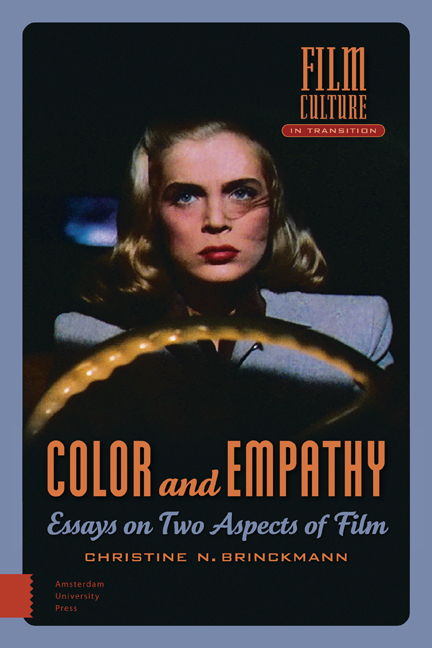Book contents
- Frontmatter
- Contents
- Preface
- Dedication
- Cinematic Color as Likeness and as Artifact: [2001]
- Chords of Color: [2006]
- The Tension of Colors in Colorized Silent Films: [2001]
- Structural Film, Structuring Color: Jenny Okun's Still Life: [1995]
- Desert Fury: A Film Noir in Color: [2012]
- The Work of the Camera: BEAU TRAVAIL: [2005]
- Empathy with the Animal: [1997]
- Motor Mimicry in Hitchcock: [1999]
- Abstraction and Empathy in the Early German Avant-garde: [1997]
- The Role of Empathy in Documentary Film: A Case Study: [2005]
- Genre Conflict in Tracey Emin’s Top Spot: [2007]
- Viewer Empathy and Mosaic Structure in Frederick Wiseman’s PRIMATE: [2009]
- CASTA DIVA: An Empathetic Reading: [2008]
- Publication Data
- Index of Films
- Index of Subjects
- Film Culture in Transition
Preface
Published online by Cambridge University Press: 23 June 2021
- Frontmatter
- Contents
- Preface
- Dedication
- Cinematic Color as Likeness and as Artifact: [2001]
- Chords of Color: [2006]
- The Tension of Colors in Colorized Silent Films: [2001]
- Structural Film, Structuring Color: Jenny Okun's Still Life: [1995]
- Desert Fury: A Film Noir in Color: [2012]
- The Work of the Camera: BEAU TRAVAIL: [2005]
- Empathy with the Animal: [1997]
- Motor Mimicry in Hitchcock: [1999]
- Abstraction and Empathy in the Early German Avant-garde: [1997]
- The Role of Empathy in Documentary Film: A Case Study: [2005]
- Genre Conflict in Tracey Emin’s Top Spot: [2007]
- Viewer Empathy and Mosaic Structure in Frederick Wiseman’s PRIMATE: [2009]
- CASTA DIVA: An Empathetic Reading: [2008]
- Publication Data
- Index of Films
- Index of Subjects
- Film Culture in Transition
Summary
The present volume – Color and Empathy – brings together a number of essays on two areas of research that have been at the core of my work for several decades, in my writing as well as in the classroom. Although both areas firmly belong to the center of the discipline, they had until recently been marginalized in film studies.
In the case of cinematic color, the neglect might have to do with the uniquely sensuous nature of color, whose elusiveness makes it difficult to name, gauge, and analyze chromatic phenomena. But there is also the fact that Western culture has accorded color a minor, even lowly status for many centuries – a Puritanical attitude which peaked in the 19th century. At the same time, however, color has been of eminent importance in the world of fashion, and there is, of course, a rich tradition of color in painting and the art of design. Cinematic color can be seen in this tradition, and film history can boast many examples in which color has been orchestrated with artistry and sophistication.
In the case of empathy, neglect stemmed from a lack of attention to the viewer as an entity crucial for understanding films and the cinema. Early on, there had been the seminal work of Hugo Munsterberg on silent fiction film, but few scholars chose to follow in Munsterberg's wake. The psychology of the audience was mainly left to psychologists whose findings were rarely taken up in film studies, or to Hollywood producers and critics who commented upon the experience of the viewer in vague terms like “identification” or “vicarious experience.” In another field, in German art theory of the late 19th and early 20th centuries, empathy had figured quite prominently as a factor in the reception of art. But it was only in the middle of the 1990s and in step with the so-called “emotional turn” in cultural theory that empathy suddenly entered center stage in audience studies.
Since the essays in this volume were first published, much work has come out on both subjects: books and articles on cinematic color now cover a whole range of aspects, and studies on empathy have become ever more variegated and differentiated.
- Type
- Chapter
- Information
- Color and EmpathyEssays on Two Aspects of Film, pp. 7 - 9Publisher: Amsterdam University PressPrint publication year: 2014



